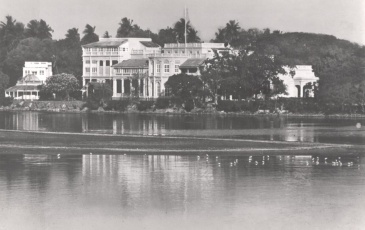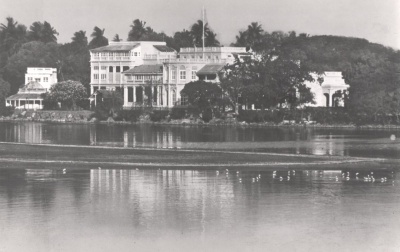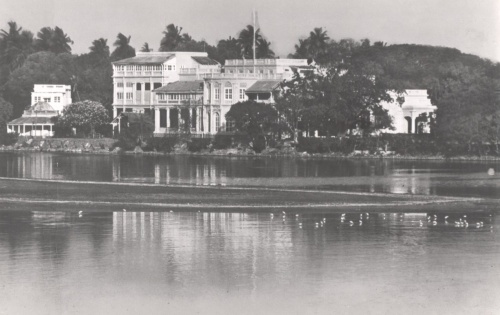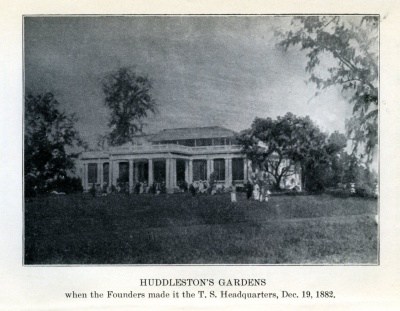Adyar (campus): Difference between revisions
| Line 85: | Line 85: | ||
=== First Trilithon === | === First Trilithon === | ||
In 1905, [[José Xifré|Don José Xifré]] financed the '''Vasantapuram gateway''' | In 1905, [[José Xifré|Don José Xifré]] financed the '''Vasantapuram gateway'''.<ref>''The International Theosophical Year Book 1938'' (Adyar, Madras, India: Theosophical Publishing House, 1938): 223.</ref> | ||
Note: Is Vasantapuram the first or third trilithon? | |||
=== Second Trilithon === | === Second Trilithon === | ||
Revision as of 03:19, 20 October 2019
ARTICLE UNDER CONSTRUCTION
ARTICLE UNDER CONSTRUCTION
Adyar is the name by which the headquarters estate of the Theosophical Society has been known since 1882.
History
Purchase of the estate
On April 23, 1882, the Founders, Helena Petrovna Blavatsky and Henry Steel Olcott, arrived by ship at Madras, where they met T. Subba Row, Judge G. Muthuswamy Chetty and his sons G. Soobiah Chetty and G. Narasimhulu Chetty, Ragunath Row, among others.
The Madras Times of April 24 or 25, 1882, describes their arrival as follows"
THEOSOPHISM AT MADRAS. — Madame Blavatsky and Colonel Olcott, the well-known founders of the Theosophical Society in Bombay, arrived at Madras on Sunday morning at nine o'clock. In anticipation of their arrival, the natives assembled, and made arrangements to give their visitors a formal reception at five o'clock in the evening. Accordingly, at the hour fixed, the native community mustered strong at the pier, among whom were the Hon'ble Rajah Gajapathi Row, the Dewan Bahadur Ragunatha Row, and several leading members and merchants of the community. Boats went out to meet the steamer, the one destined for the visitors tastefully decorated. After an interchange of compliments and much cheering, the visitors were ushered into a saloon carriage, afterwards to a carriage and four, and driven to the residence fitted up for them. . . . The Deputy Inspector of Schools read the following address: ”We, the undersigned, who entertain great respect for you, welcome you to the capital of Southern India. We need hardly express our appreciation of your valuable services for our country, and we trust that your advent here will be a means of placing within our reach the advantages afforded for investigating the mysteries of nature and psychical powers latent in man".[1]
While the Founders were there, the Madras Theosophical Society was formed, and the idea of moving the Headquarters from Bombay to Madras (previously suggested by G. Soobiah Chetty) was discussed at a meeting.
On May 31 the Chetty brothers took them to see a piece of property they recommended as the new headquarters site for the Theosophical Society: the "Huddlestone's Gardens". The Huddlestone family had been granted some property south of the Adyar River in the late 1780s, on which they built a country or "garden" house. But now the twenty-seven-acre property, containing a large house, two cottages, and other facilities, was on sale.
When the Founders saw the Huddlestone's Gardens Mme. Blavatsky declared "Master wants this purchased". Col. Olcott wrote that "at first glance [we] knew that our future home was found".
The Society had not enough funds to purchase the property but the necessary sum was advanced by a devoted member, P. Iyaloo Naidu. Then, a circular to collect donations from members was issued. On November 17, exactly seven years after the founding of the Theosophical Society, the final balance of Rs. 7,000 was paid by Judge G. Muthuswamy Chetty. This completed the sale and the title to the property passed to the Society.[2]
On December 17 the Founders left Bombay by train heading for Adyar, accompanied by the Emma and Alexis Coulomb, Damodar, "Mr. Deb", Dora Swami Naidu, and five Hindu servants. They arrived on the 19th. On January 14, 1883, Col. Olcott issued a circular regarding how Adyar was bought and paid for.
Growth of the estate
Besant Grove
Early in the presidency of Annie Besant, she accepted the gift of land that was named Besant Grove:
JUST before leaving Adyar I received a very nice parting present. A friend, who withholds his name, purchased the plot of land of about twenty acres which occupies the corner where the Adyar river runs into the sea, being bounded thus on two sides by water, and which has as its southern boundary Olcott Gardens and as its western Blavatsky Gardens. This plot he has presented to me, labelling it Besant Grove. I have accepted it, in order to hand it over to the Theosophical Society, and it forms a very valuable addition to the Headquarters' property, completing the parallelo gram marked out by river, sea, and high-roads.[3]
Adyar as an administrative center
Headquarters Building
Administration Building
Adyar Library and Research Centre
Archives and Museum
Vasanṭā Press
The Vasanṭā Press was established in 1909 by Annie Besant. It moved to its current location in 1968. The press prints books, pamphlets, and other publications produced by the Theosophical Publishing House, the Adyar Library and Research Centre, and allied organizations.
Editorial Office for The Theosophist
Leadbeater Chambers
Blavatsky Bungalow
Adyar Library and Research Centre
Bookstore
Adyar as a spiritual center
Religious buildings
Social and educational services
Olcott Memorial School
The Olcott Memorial School was started by Col. Henry Steel Olcott in the year 1894 to empower economically disadvantaged children through the provision of free education. It was upgraded to the level of a High School in the year 1975, and in 2013 it was upgraded to further to the level of a Higher Secondary School (up to Class XII).
HPB Hostel
Provides a home for over 25 boys who are in need. They are students of the Olcott Memorial School.
Social Welfare Centre
The Social Welfare Centre takes care of around 100 infants, with free nutrition, clothes, pre-school training, and other services.
Besant Memorial Animal Dispensary
The dispensary is an outreach program for animal welfare run by the Theosophical Society in Besant Nagar, Chennai since about 1990. It provides treatment daily to more than 30 animals a day. Injured and abandoned animals are treated free of charge, and vaccinations are available.
Features of the grounds
First Trilithon
In 1905, Don José Xifré financed the Vasantapuram gateway.[4]
Note: Is Vasantapuram the first or third trilithon?
Second Trilithon
Prince Harisinghji Rupsinghji "donated in the name of his wife the second 'Trilithon,' which is west of the Headquarters Hall at Adyar."[5]
Banyan Tree
Gardens
Beautiful trees and flowering plants are found throughout the Adyar estate. Many members have brought plants from other continents to add variety to the gardens.
From the earliest days, various crops have contributed to the income of the estate and the diet of the staff. Coconuts, mangoes, jackfruit and other fruits continue to be grown. For a time, there was a rice paddy. In 1952, Mr. Cook wrote, "Once again the Society has grown on its estate India's finest paddy (rice) crop, a spectacular yield per acre of 3,850 pounds of very superior grade. Experiments are in progress to bring about further improvement. This yield comes from careful election of seed and thorough tilling by the still primitive bullock-drawn ploughs in suitable soil."[6]
Adyar River and beach
Online resources
Articles
- "Old Diary Leaves" (on the purchase of the Estate) by G. Subbiah Chetty
Video
- Adyar: Home of the Theosophical Society by Steve Schweizer (Documentary)
Additional resources
- Photos from Adyar
- Official TS Adyar website
- Adyar TS Estate: Descriptions, Books, Maps, Videos, & Photos compiled by Daniel Caldwell
 
|
- Name.jpg
- Name.jpg
- Name.jpg
- Name.jpg
Label, date.
Notes
- ↑ A Sketch of the Theosophic Organization at http://hpb.narod.ru/SketchTheosophicOrganization.htm
- ↑ Adele Algeo, "Blavatsky at Adyar--From her Letters", The Theosophist 129:9 (June 2008),340.
- ↑ Annie Besant, "On the Watch-Tower" The Theosophist 30.9 (June, 1909), 267.
- ↑ The International Theosophical Year Book 1938 (Adyar, Madras, India: Theosophical Publishing House, 1938): 223.
- ↑ C. Jinarajadasa, Letters from the Masters of the Wisdom, Second Series (Adyar, Madras, India: Theosophical Publishing House, 1925), 146.
- ↑ "Sidney A. Cook, "Adyar Administrative Notes," The American Theosophist 40.5 (May, 1 952), 86.

